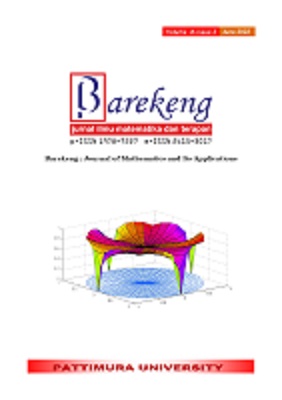MATHEMATICAL MODEL OF THREE SPECIES FOOD CHAIN WITH INTRASPECIFIC COMPETITION AND HARVESTING ON PREDATOR
Abstract
This research develops a mathematical model of three species of food chains between prey, predator, and top predator by adding intraspecific competition and harvesting factors. Interaction between prey with predator and interaction between predator with top predator uses the functional response type II. Model formation begins with creating a diagram food chain of three species compartments. Then a nonlinear differential equation system is formed based on the compartment diagram. Based on this system four equilibrium points are obtained. Analysis of local stability at the equilibrium points by linearization shows that there is one unstable equilibrium point and three asymptotic stable local equilibrium points. Numerical simulations at equilibrium points show the same results as the results of the analysis. Then numerical simulations on several parameter variations show that intraspecific competition has little effect on population changes in predator and top predator. While the harvesting parameter predator affects the population of predator and top predator.
Downloads
References
H. Molla, S. Sarwardi, S. R. Smith, and M. Haque, “Dynamics of adding variable prey refuge and an Allee effect to a predator–prey model,” Alexandria Engineering Journal, 2021, doi: 10.1016/j.aej.2021.09.039.
M. Das and G. P. Samanta, “A delayed fractional order food chain model with fear effect and prey refuge,” Mathematics and Computers in Simulation, vol. 178, pp. 218–245, 2020, doi: https://doi.org/10.1016/j.matcom.2020.06.015.
Y. Li and M. Wang, “Stationary pattern of a diffusive prey–predator model with trophic intersections of three levels,” Nonlinear Analysis: Real World Applications, vol. 14, no. 3, pp. 1806–1816, 2013, doi: https://doi.org/10.1016/j.nonrwa.2012.11.012.
P. Turchin, Complex population dynamics. Princeton university press, 2013.
I. Taufiq and D. Agustito, “Application of Mathematical Models Two Predators and Infected Prey by Pesticide Control in Nilaparvata Lugens Spreading in Bantul Regency,” InPrime: Indonesian Journal of Pure and Applied Mathematics, vol. 2, no. 1, pp. 41–50, 2020, doi: 10.15408/inprime.v2i1.14887.
A. Hastings and T. Powell, “Chaos in a three‐species food chain,” Ecology, vol. 72, no. 3, pp. 896–903, 1991.
A. Klebanoff and A. Hastings, “Mathematical 61olo9y Chaos in three species food chains,” 1994.
C.-H. Chiu and S.-B. Hsu, “Extinction of top-predator in a three-level food-chain model,” 1998.
Y. Chen, J. Yu, and C. Sun, “Stability and Hopf bifurcation analysis in a three-level food chain system with delay,” Chaos, Solitons and Fractals, vol. 31, no. 3, pp. 683–694, Feb. 2007, doi: 10.1016/j.chaos.2005.10.020.
B. W. Kooi, M. P. Boer, and S. A. L. M. Kooijman, “Consequences of population models for the dynamics of food chains,” 1998.
M. Haque, N. Ali, and S. Chakravarty, “Study of a tri-trophic prey-dependent food chain model of interacting populations,” Mathematical Biosciences, vol. 246, no. 1, pp. 55–71, Nov. 2013, doi: 10.1016/j.mbs.2013.07.021.
A. D. Bazykin, Nonlinear dynamics of interacting populations. World Scientific, 1998.
B. Mukhopadhyay and R. Bhattacharyya, “Effects of harvesting and predator interference in a model of two-predators competing for a single prey,” Applied Mathematical Modelling, vol. 40, no. 4, pp. 3264–3274, Feb. 2016, doi: 10.1016/j.apm.2015.10.018.
W. E. Boyce, R. C. DiPrima, and D. B. Meade, Elementary differential equations and boundary value problems. John Wiley & Sons, 2021.
C. S. Holling, “The components of predation as revealed by a study of small-mammal predation of the European Pine Sawfly1,” The Canadian Entomologist, vol. 91, no. 5, pp. 293–320, 1959.
P. A. Abrams and J. D. Roth, “Ecological Society of America The Effects of Enrichment of Three-Species Food Chains with Nonlinear Functional Responses,” 1994. [Online]. Available: http://www.jstor.orgURL:http://www.jstor.org/stable/1939435http://www.jstor.org/stable/1939435?seq=1&cid=pdf-reference#references_tab_contents
P. Hogeweg and B. Hesper, “Interactive instruction on population interactions,” Computers in biology and medicine, vol. 8, no. 4, pp. 319–327, 1978.
V. Rai and R. Sreenivasan, “Period-doubling bifurcations leading to chaos in a model food chain,” Ecological modelling, vol. 69, no. 1–2, pp. 63–77, 1993.
K. Mccann and P. Yodzis, “Bifurcation structure of a three-species food-chain model,” Theoretical population biology, vol. 48, no. 2, pp. 93–125, 1995.
M. Scheffer, “Should we expect strange attractors behind plankton dynamics-and if so, should we bother?,” 1991. [Online]. Available: http://plankt.oxfordjournals.org/
H. Agus Mulyadi, D. Abdul, and W. Radjab, “DYNAMICS OF SPATIAL ABUNDANCE OF ZOOPLANKTON IN MORELLA COASTAL WATERS, CENTRAL MALUKU,” 2015. [Online]. Available: http://itk.fpik.ipb.ac.id/ej_itkt71
Authors who publish with this Journal agree to the following terms:
- Author retain copyright and grant the journal right of first publication with the work simultaneously licensed under a creative commons attribution license that allow others to share the work within an acknowledgement of the work’s authorship and initial publication of this journal.
- Authors are able to enter into separate, additional contractual arrangement for the non-exclusive distribution of the journal’s published version of the work (e.g. acknowledgement of its initial publication in this journal).
- Authors are permitted and encouraged to post their work online (e.g. in institutional repositories or on their websites) prior to and during the submission process, as it can lead to productive exchanges, as well as earlier and greater citation of published works.






1.gif)



